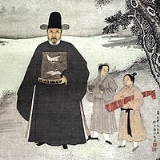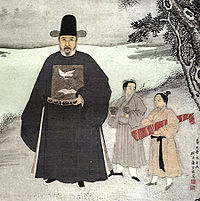
Mandarin square
Encyclopedia
A Mandarin square also known as a rank badge, was a large embroidered badge sewn onto the surcoat of an official
in Imperial China. It was embroidered with detailed, colourful animal or bird insignia indicating the rank of the official wearing it.
 Mandarin squares were first authorized for wear in 1391 by the Ming Dynasty
Mandarin squares were first authorized for wear in 1391 by the Ming Dynasty
. The use of squares depicting birds for civil officials and animals for military officials was an outgrowth of the use of similar squares, apparently for decorative use, in the Yuan Dynasty
. The original court dress regulations of the Ming Dynasty were published in 1368, but did not refer to badges as rank insignia. These badges continued to be used through the remainder of the Ming and the subsequent Qing Dynasty
until the imperial system fell in 1912.
Ming nobles and officials wore their rank badges on full-cut red robes with the design stretching from side to side, completely covering the chest and back. This caused the badges to be slightly trapezoidal with the tops narrower than the bottom. The Ming statute
s never refer to the number of birds or animals that should appear on the badges. In the beginning, two or three were used. In a typical example of paired birds, they were shown in flight on a background of bright cloud streamers on a gold background. Others showed one bird on the ground with the second in flight. The addition of flowers produced an idealized naturalism.
had their respective official clothes. Princes, including Qin Wang and Jun Wang, usually wore black robes as opposed to the blue robes in court, and had four circular designs, one on each shoulder, front, and back, as opposed to the usual front-and-back design. Specifically, Princes of the Blood used four front-facing dragons, Qin Wang had two front-facing and two side-facing dragons, and Jun Wang had four side-facing ones; all had five claws on each foot. Beile and Beizi had a circular design on their official clothing, the former having two front-facing dragons, the latter two side-facing ones; these dragon had only four claws on each foot, and are referred to as "drakes" or "great serpents" (巨蟒 jù-mǎng). National Duke, General
, Efu, "Commoner" Duke
, Marquis
and Count
had two front-facing, four-clawed dragons on square designs, whereas Viscount
and Baron
had cranes and golden pheasants, as for Mandarins of the First and Second Class.
Musician
s used the Oriole
.
Mandarin (bureaucrat)
A mandarin was a bureaucrat in imperial China, and also in the monarchist days of Vietnam where the system of Imperial examinations and scholar-bureaucrats was adopted under Chinese influence.-History and use of the term:...
in Imperial China. It was embroidered with detailed, colourful animal or bird insignia indicating the rank of the official wearing it.
Ming Dynasty

Ming Dynasty
The Ming Dynasty, also Empire of the Great Ming, was the ruling dynasty of China from 1368 to 1644, following the collapse of the Mongol-led Yuan Dynasty. The Ming, "one of the greatest eras of orderly government and social stability in human history", was the last dynasty in China ruled by ethnic...
. The use of squares depicting birds for civil officials and animals for military officials was an outgrowth of the use of similar squares, apparently for decorative use, in the Yuan Dynasty
Yuan Dynasty
The Yuan Dynasty , or Great Yuan Empire was a ruling dynasty founded by the Mongol leader Kublai Khan, who ruled most of present-day China, all of modern Mongolia and its surrounding areas, lasting officially from 1271 to 1368. It is considered both as a division of the Mongol Empire and as an...
. The original court dress regulations of the Ming Dynasty were published in 1368, but did not refer to badges as rank insignia. These badges continued to be used through the remainder of the Ming and the subsequent Qing Dynasty
Qing Dynasty
The Qing Dynasty was the last dynasty of China, ruling from 1644 to 1912 with a brief, abortive restoration in 1917. It was preceded by the Ming Dynasty and followed by the Republic of China....
until the imperial system fell in 1912.
Ming nobles and officials wore their rank badges on full-cut red robes with the design stretching from side to side, completely covering the chest and back. This caused the badges to be slightly trapezoidal with the tops narrower than the bottom. The Ming statute
Statute
A statute is a formal written enactment of a legislative authority that governs a state, city, or county. Typically, statutes command or prohibit something, or declare policy. The word is often used to distinguish law made by legislative bodies from case law, decided by courts, and regulations...
s never refer to the number of birds or animals that should appear on the badges. In the beginning, two or three were used. In a typical example of paired birds, they were shown in flight on a background of bright cloud streamers on a gold background. Others showed one bird on the ground with the second in flight. The addition of flowers produced an idealized naturalism.
Qing Dynasty
There was a sharp difference between the Ming and Qing styles of badges: the Qing badges were smaller with a decorative border. And, while the specific birds and animals did not change much throughout their use, the design of the squares underwent an almost continual evolution. According to rank, Qing-Dynasty noblesChinese nobility
Chinese sovereignty and peerage, the nobility of China, were an important feature of traditional social and political organization of Imperial China. While the concepts of hereditary sovereign and peerage titles and noble families were featured as early as the semi-mythical, early historical...
had their respective official clothes. Princes, including Qin Wang and Jun Wang, usually wore black robes as opposed to the blue robes in court, and had four circular designs, one on each shoulder, front, and back, as opposed to the usual front-and-back design. Specifically, Princes of the Blood used four front-facing dragons, Qin Wang had two front-facing and two side-facing dragons, and Jun Wang had four side-facing ones; all had five claws on each foot. Beile and Beizi had a circular design on their official clothing, the former having two front-facing dragons, the latter two side-facing ones; these dragon had only four claws on each foot, and are referred to as "drakes" or "great serpents" (巨蟒 jù-mǎng). National Duke, General
General
A general officer is an officer of high military rank, usually in the army, and in some nations, the air force. The term is widely used by many nations of the world, and when a country uses a different term, there is an equivalent title given....
, Efu, "Commoner" Duke
Duke
A duke or duchess is a member of the nobility, historically of highest rank below the monarch, and historically controlling a duchy...
, Marquis
Marquis
Marquis is a French and Scottish title of nobility. The English equivalent is Marquess, while in German, it is Markgraf.It may also refer to:Persons:...
and Count
Count
A count or countess is an aristocratic nobleman in European countries. The word count came into English from the French comte, itself from Latin comes—in its accusative comitem—meaning "companion", and later "companion of the emperor, delegate of the emperor". The adjective form of the word is...
had two front-facing, four-clawed dragons on square designs, whereas Viscount
Viscount
A viscount or viscountess is a member of the European nobility whose comital title ranks usually, as in the British peerage, above a baron, below an earl or a count .-Etymology:...
and Baron
Baron
Baron is a title of nobility. The word baron comes from Old French baron, itself from Old High German and Latin baro meaning " man, warrior"; it merged with cognate Old English beorn meaning "nobleman"...
had cranes and golden pheasants, as for Mandarins of the First and Second Class.
Tables
The specific birds and animals used to represent rank varied only slightly from the inception of mandarin squares until the end of the Qing Dynasty. These tables show this evolution.Military
| Rank | Ming (1391–1526) | Ming and Qing (1527–1662) | Late Qing (1662–1911) |
|---|---|---|---|
| 1 | Lion | Lion | Qilin (after 1662) |
| 2 | Lion | Lion | Lion |
| 3 | Tiger or Leopard | Tiger | Leopard (after 1664) |
| 4 | Tiger or Leopard | Leopard | Tiger (after 1664) |
| 5 | Bear | Bear | Bear |
| 6 | Panther | Panther | Panther |
| 7 | Panther | Panther | Rhinoceros (after 1759) |
| 8 | Rhinoceros | Rhinoceros | Rhinoceros |
| 9 | Rhinoceros | Sea Horse | Sea Horse |
Civilian
| Rank | Ming (1391–1526) | Ming and Qing (1527–1662) | Late Qing (1662–1911) |
|---|---|---|---|
| 1 | Crane or Golden Pheasant | Crane | Crane |
| 2 | Crane or Golden Pheasant | Golden Pheasant | Golden Pheasant |
| 3 | Peacock or Wild Goose | Peacock | Peacock |
| 4 | Peacock or Wild Goose | Wild Goose | Wild Goose |
| 5 | Silver Pheasant | Silver Pheasant | Silver Pheasant |
| 6 | Egret or Mandarin Duck | Egret | Egret |
| 7 | Egret or Mandarin Duck | Mandarin Duck | Mandarin Duck |
| 8 | Oriole, Quail or Paradise Flycatcher | Oriole | Quail |
| 9 | Oriole, Quail or Paradise Flycatcher | Quail | Paradise Flycatcher |
Musician
Musician
A musician is an artist who plays a musical instrument. It may or may not be the person's profession. Musicians can be classified by their roles in performing music and writing music.Also....* A person who makes music a profession....
s used the Oriole
Oriole
Orioles are colourful Old World passerine birds in the genus Oriolus, the namesake of the corvoidean family Oriolidae. They are not related to the New World orioles, which are icterids and, belonging to the superfamily Passeroidea songbirds, are quite unrelated to the true orioles.The orioles are...
.
See also
- Rank badgeRank badgeThis rank badge is a small yet beautifully executed panel of embroidery that would have served to indicate the status of a government official in the Choson Dynasty Korea...
, for the analogous design in Korea - Hanfu, GwanbokGwanbokGwanbok is a Korean general term referring to all business attires of government officers given by government, with Rank badge on them to distinguish hierarchies. It began to be worn since Silla period until Joseon Dynasty...
- Chinese hat knob
- Byzantine dressByzantine dressByzantine dress changed considerably over the thousand years of the Empire, but was essentially conservative. The Byzantines liked colour and pattern, and made and exported very richly patterned cloth, especially Byzantine silk, woven and embroidered for the upper classes, and resist-dyed and...
for the similar "tablion" - Nine-rank systemNine-rank systemThe nine rank system , or much less commonly nine grade controller system, was a civil service nomination system during the Three Kingdoms and the Southern and Northern Dynasties in China...
, for an earlier system for ranking officials in China
Further reading
- "Rank insignia for military officers of the imperial court", in:

